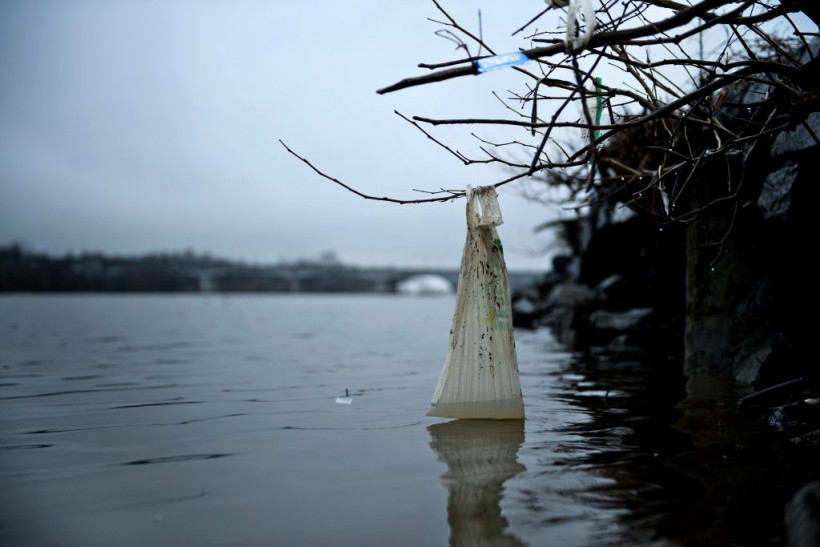American University's research team conducted a three-year study, titled "Microplastics and Polycyclic Aromatic Hydrocarbons: Abundance, Distribution, and Chemical Analyses in the Nash Run, an Urban Tributary to the Anacostia River (Washington, DC, USA)" published in in the journal Water, Air, & Soil Pollution, about the freshwater streams flowing into Washington, D.C.'s Anacostia River, focusing on microplastics.
These pollutants pose a threat to river quality, sediments, and aquatic life. The research aims to share information on plastic regulations, particularly for single-use plastics with initial findings providing valuable insights into D.C.'s microplastic situation, filling a regional research gap.

A plastic bag is seen washed up on the banks of the Anacostia River on March 21, 2019 in Washington, DC.
Microplastics in D.C.'s Waterways
Microplastics are consistently found in Nash Run throughout the year. The area is located in Southeast D.C., is one of several river tributaries in D.C. and Maryland studied by a research team for microplastics.
Water samples from there contained between 24 to 127 microplastic particles per liter, but assessing whether this is a significant amount is challenging due to the diverse nature and sizes of microplastics. Standardized testing methods are needed for better assessment.
The primary microplastic type in Nash Run is high-density polyethylene (HDPE), commonly used in various products such as milk containers, shampoo bottles, and detergents.
Microplastics are small fragments of larger plastics or are intentionally added to products like cosmetics. They are widespread in freshwater, oceans, and can be found in various animals, including clams, oysters, fish, and even in humans, as studies have shown in lung tissue and newborns' placentas.
The health risks posed by microplastics to both humans and animals are still being studied extensively. Removing microplastics from waterways is challenging due to their size.
To address this issue, businesses and governments are adopting sustainability goals to reduce single-use plastic usage and implementing measures like plastic bag bans and restrictions on single-use plastics and utensils in dining establishments.
READ ALSO: Scientists Trace Microplastic Pollution Almost Everywhere, It's Become Airborne
Protecting D.C.'s Anacostia River
The health of D.C.'s Anacostia River has long been a concern for government and nonprofit organizations. Stephen MacAvoy, an environmental science associate professor, and his students research contaminants affecting freshwater and its wildlife.
Their work involves studying the river's geochemistry, understanding unusual chemical patterns, and monitoring changes as water quality improvement efforts continue.
Microplastics, detected in the river, pose an additional challenge to its ecosystem. MacAvoy highlights the persistent struggle to improve the river's health, often followed by setbacks.
In addition to microplastics, researchers identified other pollutants in sediment, including phenanthrene, fluoranthene, and pyrene (PAHs), requiring further investigation into their sources.
While microplastics' impact on animal life is well-documented, some animals, like mussels, consume microplastics, potentially aiding in mitigation efforts. Freshwater systems have received less attention than oceans in microplastics research, underscoring the need for continued monitoring of tributaries, sediment, and the river itself.
The research team plans to expand its sampling projects in the river and Potomac watershed while collaborating with regional microplastics researchers to build a baseline for D.C. and inform policymakers about this pollution issue.
RELATED ARTICLE: Microplastics Found in Human Blood For The First Time; How Do These Tiny Particles Affect Our Health?
Check out more news and information on Microplastics in Science Times.














